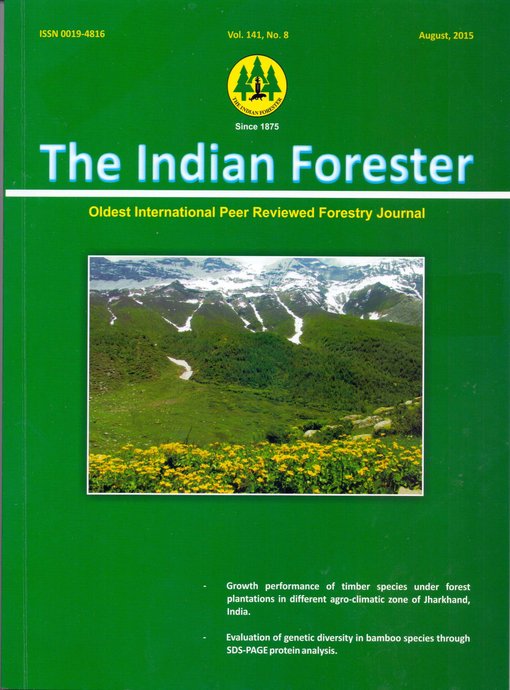Endangering Sacred Groves of a Non forested Region in Kerala, India and Strategies for their Conservation
DOI:
https://doi.org/10.36808/if/2015/v141i8/76994Keywords:
Sacred Groves, Phytosociology, Floristics, Hotspots, Endemism.Abstract
Alappuzha is the only district in Kerala state without natural forests. Therefore, sacred groves of this region attract utmost attention as they are the only remnants of natural forests once present. An exhaustive survey carried out in Alappuzha district revealed the presence of 1128 sacred groves varying in extent. Plant species numbering 687 were recorded from the sacred groves covering an area of 83.55 ha of Alappuzha district. They belonged to 493 genera and 127 families. Many valuable medicinal plants and wild relatives of cultivated species have been recorded which are important in species improvement programmes. Twenty-seven species were found to be endemic to Western Ghats. Most of the sacred groves in Alappuzha were proved to be invaluable resource pockets of floristic diversity. Many sacred groves in the district face threat due to the dense human population and change in socio-economic status. Break up of ancestral joint family system to nuclear families is the major reason for deterioration of these valuable resources. 'Ulladans', the tribal community collect canes and firewood indiscriminately. Overexploitation of the resources by them has lead to its retrogression to a great extent. Removal of litter alongwith the seeds from the floor has also resulted in retrogression by hindering the natural regeneration process. Exotic weeds namely, Mikania micrantha, Lantana camera and Chromolaena odorata overgrow the native species and play a major role in degradation. A detailed database on important sacred groves containing all the vital information including soil type, nutritional status, flora, fauna, plant associations, population structure, cultural and religious aspects and management operations will help in prescribing site specific conservation strategy.References
Balasubramanian K. and Induchoodan N.C. (1999). Can the endemics of the sacred groves in Kerala withstand human onslaught? In: Endemic and Endangered Plant and Animal Species of Eastern and Western Ghats (G. Kumaravelu and K.K. Chaudhuri (Eds), Tamil Nadu Forest Department, Chennai, India, pp 59-64.
Bourdillon T.F. (1908). The Forest Trees of Travancore, Government Press, Trivandrum.
Curtis J.T. (1959). Vegetation of Wisconsin. An ordination of plant communities, Univ. of Wisconsin Press, Madison, Wisconsin.
GOI (2007) Department of Information Technology,. Available on the web: http://alappuzha.nic.in. Accessed on 3rd March 2008.
Gamble J.S. and Fischer C.E.C. (1915-1936). The Flora of the Presidency of Madras Adlard and Son Ltd., London.
Induchoodan N.C. (1996). Ecological Studies on the Sacred Groves of Kerala Dissertation, Salim Ali School of Ecology and Environmental Science, Pondicherry University, Pondicherry, India.
Jain S.K. and Sastry A.R.K. (1984). The Indian Plant Red Data Book, Botanical Survery of India, Calcutta.
Magurran A.F. (1988). Ecological Diversity and its Measurements, University Press. Cambridge.
Misra R. (1968). Ecological Work Book, Oxford and IBH Publishing Co., New Delhi.
Mohanan C. and Prasad G.A. (2004). The sacred groves of Kerala and their conservation. In: Workshop Papers, National Workshop on Sacred Groves, 16-18 September 2004, Kozhikode, Kerala. Ministry of Environment and Forsts, Governmenr of India and Department of Forests and Wildlife, Government of Kerala, pp 44-55.
Mohanan C.N. (1986). Flora of Quilon, Dissertation, Kerala University, Thiruvananthapuram, India.
Mueller-Dombois D. and Ellenberg H. (1974). Aims and Methods of Vegetation Ecology John Wiley and Sons, London.547 p.
Pascal J.P. and Ramesh B.R. (1987). A Field Key to the Trees and Lianas of the Evergreen Forests of the Western Ghats (India), French Institute of Pondicherry.
Philips E.A. (1959). Methods of Vegetation Study, Holt Reinhart and Winston. New York.
Ramachandran K.K. and Mohanan C.N. (1989). Studies on sacred groves of Kerala with particluar reference to conservation of rare, endemic, endangered and threatened plants of the Western Ghats, India, Report submitted to the Ministry of Environment and Forests, Government of India. Kerala Forest Research Institute, Peechi, India, pp 5.
Sasidharan N. (2004). Biodiversity Documentation for Kerala Part 6: Flowering Plants, Kerala Forest Research Institute, Peechi, Kerala, India, 702 p.
Shannon C.E. and Wiener W. (1963). The Mathematical Theory of Communication, Univ. Illinois Press. Urbana, Illinois, USA.
Simpson E.H. (1949). Measurement of diversity, Nature, 163:688.
Sorenson E.H. (1948). A method of establishing groups of equal amplitude in plant sociology based on similarity of species content, Biol. Skr., 5 (4): 1-34.
Unnikrishnan E. (1995). Utharakeralathile Visudhavanangal – Oru Paristhiti – Nadodisamskara Padanam (Sacred Groves of North Kerala - An Eco-Folklore Study). Jeevarekha, Thrissur, Kerala, India 229p.
Unnikrishnan E. (2004). An ecofolklore inquest of sacred groves of north Kerala as centres of excellence in in situ conservation. In: National Workshop on Sacred Groves, 16-18 September 2004, Kozhikode, Kerala. Ministry of Environment and Forests, Government of India and Department of Forests and Wildlife, Government of Kerala, pp 56-60.
Whiteford P.B. (1949). Distribution of woodland plants in relation to succession and clonal growth, Ecology, 30: 199-208.
Downloads
Downloads
Published
How to Cite
Issue
Section
License
Unless otherwise stated, copyright or similar rights in all materials presented on the site, including graphical images, are owned by Indian Forester.





